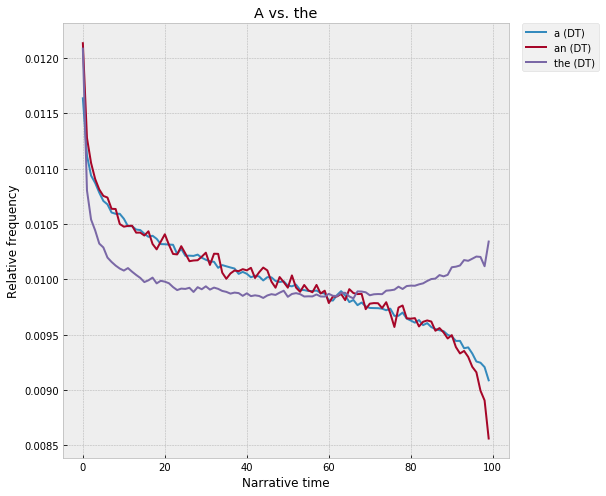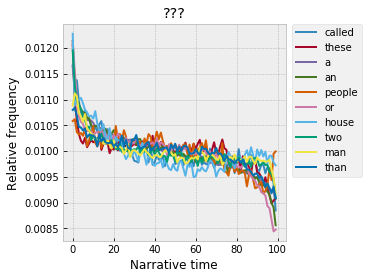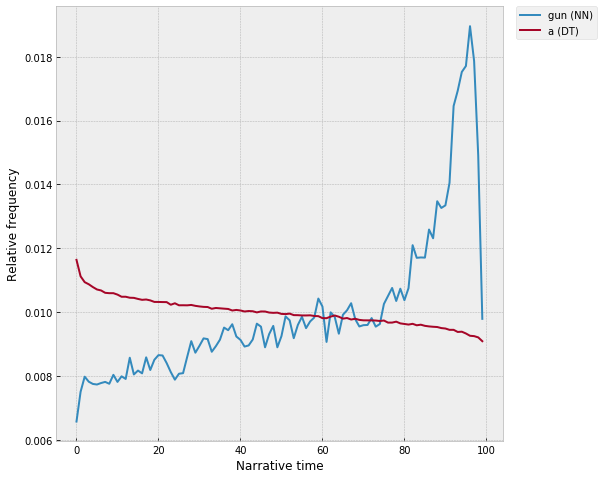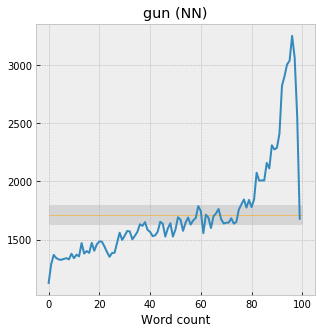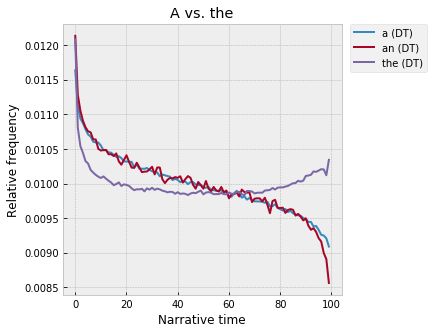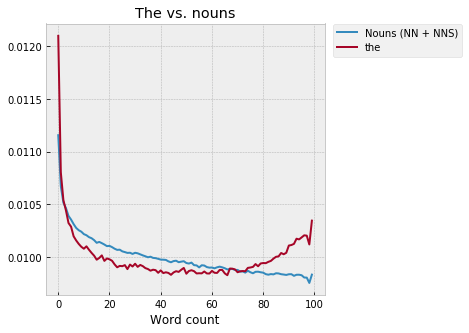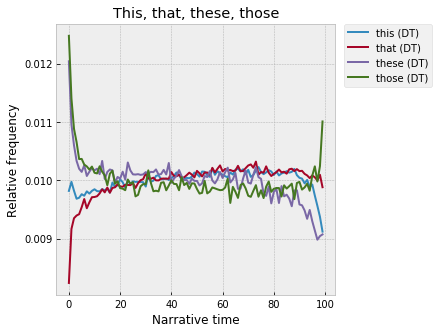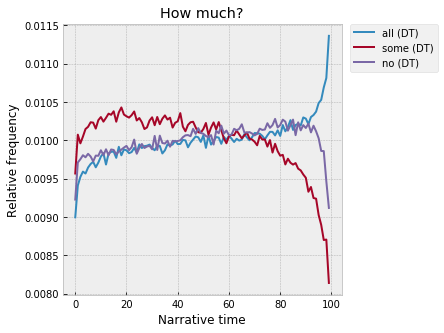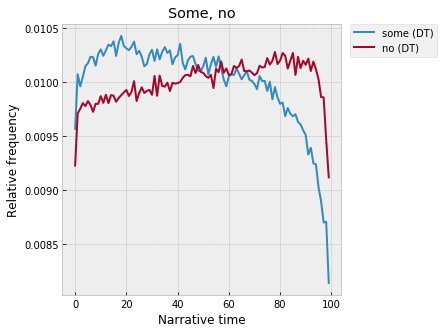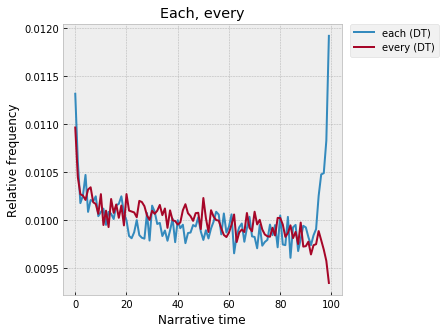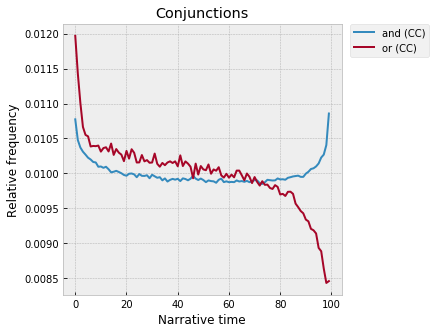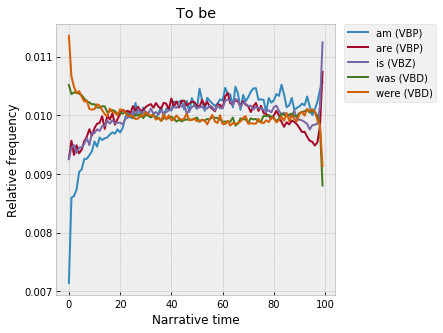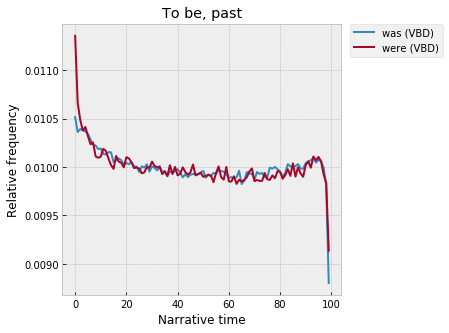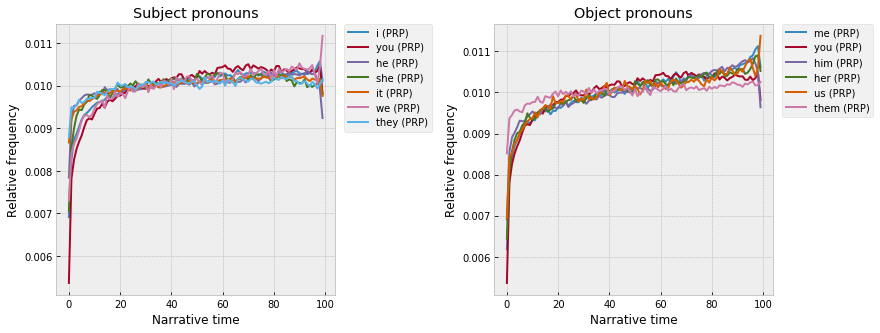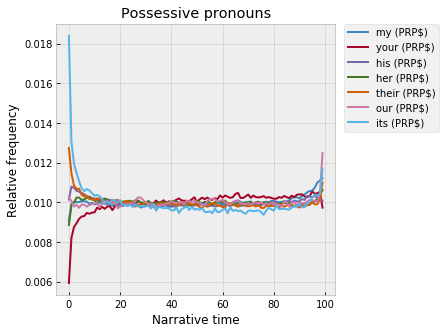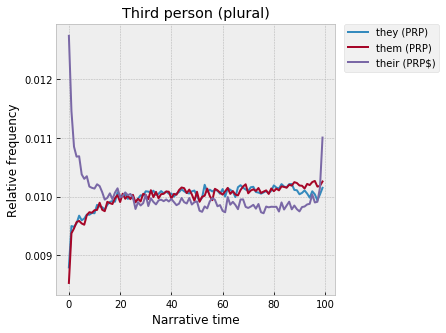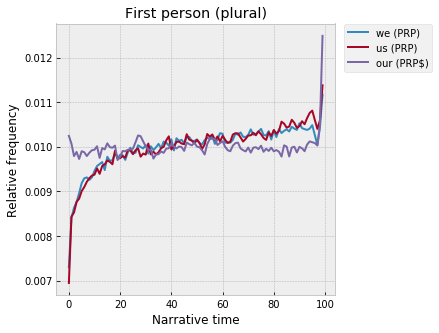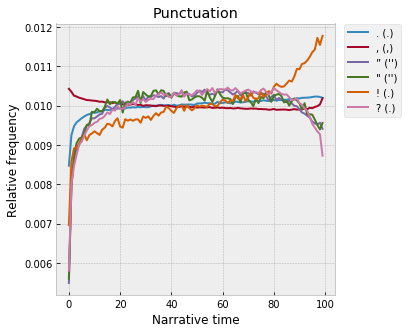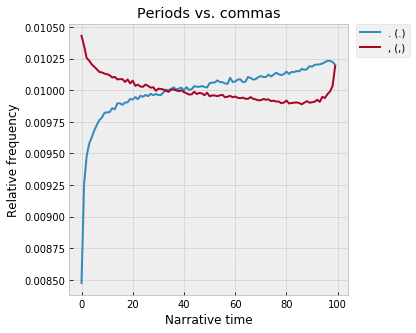The (weird) distributions of function words across novels
David McClure; Aug 10, 2017
Last week I looked at some of the clusters of words that fluctuate together across narrative time in the Lab's corpus of ~27k American novels. A lot of these are pretty semantically "legible," in the sense that it's not hard to map them back onto the experience of actually reading novels. For example, it's easy to reason about what's going on with cluster 139 (student, students, school) or 37 (pistol, bullet, gun). Which, as Ted and Scott pointed out on Twitter, might tell us more about the presence of different genres in the corpus than about "narrative," in any kind of general sense.
But, what to make of something like cluster 10? This seems more muddled, and, notably, includes a number of stopwords – “a,” “an,” “or,” “than,” “these”.
Which, it turns out, isn’t a fluke. Function words tend to have very strong trends across narrative time. In fact, stronger than almost anything else in the dictionary. Take a look again at this graph from a couple weeks ago, which plots the non-uniformity of each word as a function of its frequency:
The Y-axis is just the variance of the word's frequency across each percentile of the novel, which gives a crude measure of the unevenness of the word, the degree to which it's rising and falling across the narrative. The black line represents the null hypothesis, basically -- the amount of variance that we'd expect under the uniform distribution, if everything were just random noise. By dividing the observed variance by this theoretical baseline, we can get a simple score for the narratological volatility of the word, in a way that controls for the expected correlation with frequency.
Before, I focused on the fact that almost all of the words fall above this line, which corresponds to the fact that most words have some kind of statistically significant trend across the novel. But, beyond that, it's also clear that the slope of the data is steeper than the slope of the line -- words rise higher above the line as frequency increases. On the left side of the graph, the highest-scoring words sit about 2 orders of magnitude above the baseline; at the right side, this rises to about 3. Words seem to become more narratologically volatile as they become more frequent, even after adjusting for the expected relationship between frequency and variance.
Indeed, when we use this metric to skim off a set of the most non-uniform words, we end up getting a large majority of the most frequent words and a much smaller slice of the less frequent words. If we take the 200 highest-scoring words, for example, we get 60 out of the 100 most frequent words in the corpus, here in bold:
end, you, chapter, a, of, the, i, ., chapter, ?, i., ii, years, ", !, said, me, iii, ", him, young, she, 2, 3, he, to, her, its, ", will, i., father, school, what, and, hair, mother, god, age, ", tall, ), death, love, the, that, (, ,, year, brown, have, happy, now, life, it, not, we, your, in, ", happiness, an, new, joy, boy, or, 5, if, wedding, vii, dead, 6, again, ", old, family, do, blue, small, which, viii, l, iv, heart, large, did, published, book, gun, miss, girls, arms, do, 9, girl, would, ix, could, his, tell, ", kill, bride, told, was, college, always, black, letter, has, 8, don't, can, back, tears, know, author, last, forgive, shall, asked, go, be, die, mr., saw, had, broad, handsome, hand, gray, must, then, 7, about, fiction, think, n't, edition, books, boys, little, my, is, cried, their, us, younger, summer, older, prisoner, love, xii, 1, green, by, "you, stranger, vi, beauty, dying, grave, done, novel, village, readers, xiii, world, youth, 22, children, york, kissed, born, think, know, love, 13, mrs., town, rich, killed, story, 23, 21, still, 12, &, whose, very, wife, from, went, some, nose, 24, v., pain, see, like
What to make of this? It's kind of perplexing, and runs against what I expected at the start. I assumed that function words would be basically flat -- maybe with some very slight ups and downs -- since I don't really think of them as having any kind of narratological "valence" that would cause them to attach to beginnings / middles / ends in the way that things like death and marriage do. I thought they'd probably be negative examples of what I was looking for, almost -- the connective tissue of the language, always just there, never ebbing or flowing. (Though I also remembered Matt Jockers' finding from Macroanalysis that the word "the" rises and falls across historical time, and a little voice in my head wondered if there might be similar effects across narrative time.)
Usually, when something correlates with frequency like this, it feels like a red flag, the worry being that you're somehow just reproducing the fact that frequent words are frequent, infrequent words are infrequent. As a sanity check, and to get a sense of what the null hypothesis would look like, I re-ran the same feature extraction job on the corpus, but this time, before pulling out the percentile-sliced word counts for each text, I randomly shuffled the words to destroy any kind of narratological ordering. Sure enough:
So – as far as I can tell, I think there is actually some meaningful way in which the highest frequency words are some of the most skewed across the narrative, the most uneven, the most narratologically charged? This seemed really weird to me at first, then I convinced myself that it wasn’t actually that weird, and now I’m back to being surprised by it. But, I’m not sure. The effect is so strong, it makes me wonder – is it somehow inevitable, is there some kind of fundamental linguistic / literary / information-theoretic pressure that would make it impossible for this not to be the case, in some way?
Part of the issue, I think, is that this question of whether a word is narratologically “uneven” is actually less cut-and-dry than it seemed to me at first, and it gets caught up in interesting ways with the overall frequency of the word. For example, take “gun” and “a”:
“Gun” appears 174,286 times; “a” appears 44,510,387 times, about 255 times as often. Which of these is more “surprising”? At a kind of visual / intuitive level, “gun” obviously has the more dramatic trend – a huge spike around the 95% marker, where it literally doubles in volume relative to the baseline across the first half of the narrative. Indeed, if you convert them into probability density functions – throwing out any information about the overall frequencies – and then compare them to a uniform distribution using pretty much any goodness-of-fit test or distance metric, “gun” will always score higher by a large margin. Just using the Euclidean distance – “a” has a distance of 0.004 from the uniform distribution, whereas “gun” is 0.02, over 5x higher.
But, when you remember the actual footprint of "a" in the corpus -- 44 million occurrences, which represents about 1.8% of all words in all 27k novels -- the total quantity of linguistic "mass" that's getting displaced is sort of incredible. Here it is again, plotted this time with an error bar around the expected value of the uniform distribution -- if "a" had no trend across the plot, 95% of the bin counts would fall inside the gray band, which gets dwarfed by the actual data. In the first percentile, "a" appears 72 thousand times more than we'd expect under the uniform distribution, and 40 thousand fewer times in the last percentile. Which correspond to zscores of 109 and -61, respectively, which are absurdly large. (In fact so large, as Scott Enderle pointed out, that the uniform distribution almost feels like a meaningless / poorly-chosen null hypothesis. But, I'm not really sure what the alternative would be.)
Whereas for “gun,” the high-water mark at 95% has a zscore of 37, which of course is still huge:
“A” is flatter, but since it’s so frequent, it represents a kind of massive, tectonic displacement of words, sort of like the gravity of the moon pulling the tide in an out – the water only rises and falls a couple of feet, but in order for that to happen the entire mass of the ocean has to get moved around. The amount of narratological “energy” needed to produce the “a” trend seems much larger than for “gun,” from this perspective.
So, “gun” beats “a” in one way, but “a” beats “gun” in other ways. Which of this is more true? I spent some time going around in circles on this, but, as Dan Jurafsky and Ryan Heuser pointed out, there might not be a single right answer. Maybe more accurate just to say that there are different types of “surprise” at play, and that they operate differently at n=10^5 than at n=10^8?
To get a broader set of how that plays out across lots of words – out of the 100 most frequent words in the corpus, 90 appear in the list of the 1,000 most uneven words, under the metric from above. Here’s this list of 90, sorted from the most uneven to the least uneven, starting with the most narratologically skewed:
A vs. the
There’s too much here to go through all of it, but quickly – what’s up with “a”? There’s a remarkable symmetry to it – high at the very beginning, a fast falloff in the first 10%, a slower decline across the middle, and then a nosedive again at the very end. “An” is almost identical, though with more noise in the sample, since it’s less frequent:
There's a pretty easy explanation for this, though I'm kind of fascinated by the fact that it seems to show up at the scale of the entire narrative, and not just inside of individual passages -- "a" is used when an object is introduced for the first time, when an entity makes its first appearance in some context. For example, we might first say -- "a man was walking down the street" -- but then after that, once the man has been placed on the narrative stage, we'd switch to the definite article -- "the man walked into a shop," etc. (Franco pointed out that Benveniste makes exactly this point in Problems in General Linguistics.)
So, this is totally speculative, but -- maybe one way to think about this is to say that "a" is a proxy for the rate at which newness is getting introduced into the text? Most quickly at the start, as the fictional world is getting introduced for the first time. Then, over the course of the middle, the plot continues to move into new fictional space -- new people, new places, new objects -- but more slowly than at the beginning. And then slowest at the very end, where the plot doesn't have any space left to introduce new things. "A," in other words, gives a kind of empirical X-ray of the "speed" of the novel, in one sense of the idea -- the degree to which it's moving into new fictional contexts that have to be introduced for the first time, as opposed to standing still inside of contexts that have already been introduced? (Sort of like those old RPGs from the late 90s like Baldur's Gate or Icewind Dale, where by default the entire world of the game is black, and thing only come into view as your character moves around the map, as the spotlight falls onto new territory for the first time -- the moment of "a"?)
Is this the right explanation? I think it seems sensible, but I don't really know. The funny thing, though, is that it's not totally clear to me how you'd "prove" this, either at a linguistic or a literary register. Usually the next step would be to dip back down into individual texts and start spot-checking passages, but with a word like "a," which will appear literally millions of times in virtually all contexts, this seems like sort of a losing game. I guess the first thing would be to look at words that follow "a," and see if some kind of pattern falls out? Eg, count up all "a __" bigrams, and then find words that come after "a" most distinctively in the first percentile, as compared to the last percentile?
"The" is interestingly different:
Also very high at the start, a fast falloff in the first 10% (faster than “a”), comparatively low through the middle, and then a gradual rise at the end, starting at around 60%. So, “a” and “the” – flip sides of the same coin, grammatically – seem to do different work at a narratological level? Both seem to mark beginnings and ends, but in different ways. “A” shows something about how they are different – beginnings are building worlds, ends are inhabiting those worlds? Whereas, “the” is high at both the beginning and the end, and so, I guess, is marking something about how they are similar, a way in which the end is some kind of return to the beginning? But, in what sense?
I’m not sure about this, especially the ending. Weirdly, if we compare “the” to the combined trend for all nouns in the corpus, the ending doesn’t match up:
No idea, really. Again, to really get at this, we'd need to look at context -- the what? What words are following "the," in different parts of the narrative?
Determiners
Beyond "a" and "the" -- the other determiners are interesting:
So, at a narratological level, they basically pair up on the basis of singular / plural, not near / far. “This” and “that” are low at the beginning, peak around 70%, and then fall off at the end:
Whereas “these” and “those” are very high at the start, flat across the middle, and then split at the end, with “those” going up and “these” falling off:
JD pointed out that “this” and “that” look a lot like the dialogue clusters from last week, with the wide peak across the middle. As for “these” and “those” – I’m not sure why plurals would be so high at the beginning, but in this case it does seem to generally match up with the trend for nouns, where plurals are much higher at the start:
Though, the question then just becomes -- why plural nouns at the start? The divergence at the end is also interesting -- why does "those" spike up, and "these" fall off? Again, all of this needs much more careful attention, but -- picking up on the "geography" words from the last post, which spiked at the end -- this fits with the idea that the end is a sort of "zooming out," if we think of the narrative as a camera onto the fictional world? At the end, the narrative pans out into a wide shot of the surrounding mountains / fields / valleys, it makes itself distant from the action of the plot -- the domain of "those," not "these"?
Check out the "how much" determiners -- "all," "some," and "no" ("no" specifically as a determiner, in the sense of "there were no people in the room"):
“All” peaks at the end, the moment of generalization, completeness, closure? I’m less sure what to make of the fact that “some” peaks at 20%, but “no” at 80%:
Meanwhile, to close out the determiners – “each” skyrockets at 99%, whereas “every” stays low:
And vs. or
Conjunctions are also fascinating:
Again, there’s a tidy explanation for the split at the end, though I’m still sort of bewildered that this stuff actually shows up so strongly and at such a low level. “Or” introduces a potential branch in the narrative, a state of indeterminacy – Robert will blow the bridge, or he’ll die trying; Lucy will marry Cecil, or she will marry George; etc. And so, as the plot moves towards a close, “or” has to fall off as the ending is revealed, as uncertainty is replaced by certainty, as the plot gets sealed up as a unity and the Jamesian “circle” comes to a close?
To be
Moving on to verbs – a handful of “to be” verbs show up in the list of 90 above. Here’s everything together:
Which splits really cleanly into the present tense:
And the past:
So – the beginning is in the past tense, the middle in the present tense (dialogue, again?), but then the past tense peaks again around 95% (the climax, in some sense?), and then the present shoots back up at the very end.
Pronouns
Pronouns are also really varied. Subject and object pronouns are low at the start, rise gradually across the middle, and then kind of scramble at the end. Though, overall, the subject pronouns seem to plateau around 80%, whereas the object pronouns start to curve up a bit:
The absence at the beginning, I guess, just corresponds that things first need to be introduced with regular nouns, before they can be referred to with pronouns. Eg, “a man named Robert” has to come before “he”?
Whereas, possessives are all over the place at the start:
With “its” and “your” kind of playing foils to each other.
Breaking these out by grammatical “persons” – for the first- and third-person singulars, the possessive is always highest at the start, followed by the subject, then the object. But endings are more mixed, maybe with some interesting gender patterns – “he,” “him,” and “his” all fall off dramatically at the end, whereas “her” (as a possessive) and “my” spike up:
Meanwhile, for the third-person plural – “their,” the possessive, is super strong at the beginning and end:
And, with the first-person plurals, “our” rises highest at the end:
It’s also interesting that, for “he” / “him” and “she” / “her,” the object gradually overtakes the subject. Especially with “he” and “him,” both of which are almost exactly linear across the middle, but with “him” rising faster and higher:
So, as the narrative moves forward – things increasingly happen to people, they increasingly become grammatical objects, instead of subjects?
Punctuation
This is going on way too long, but quickly – also really zany are the punctuation tokens, which, usefully in this context, get broken out by the OpenNLP tokenizer as separate words:
Questions and dialogue happen in the middle, and endings are exclamatory:
Periods and commas also fascinate me:
The period, I assume, is basically a proxy for sentence length, where more periods mean shorter sentences? So, sentences are longest at the very beginning, and shortest just shy of the end, around 97%. I guess – long, descriptive sentences at the start, and short, staccato, action-filled sentences at the end? And it makes sense that commas would be inversely correlated – fewer periods means longer sentences, which means more commas? (And, they kiss at the end!)
Anyway, there’s sort of an infinity of stuff to look at here, and it’s hard to know where to start. I’m writing code right now to look at all of these in the context of higher-order ngrams – eg, what words are following “the” in the 99th percentile? And beyond that, I think most interesting – would it be possible to use these kinds of trends in really high-frequency words to train classifiers that could “unshuffle” novels, a predictive model of narrative sequence?
